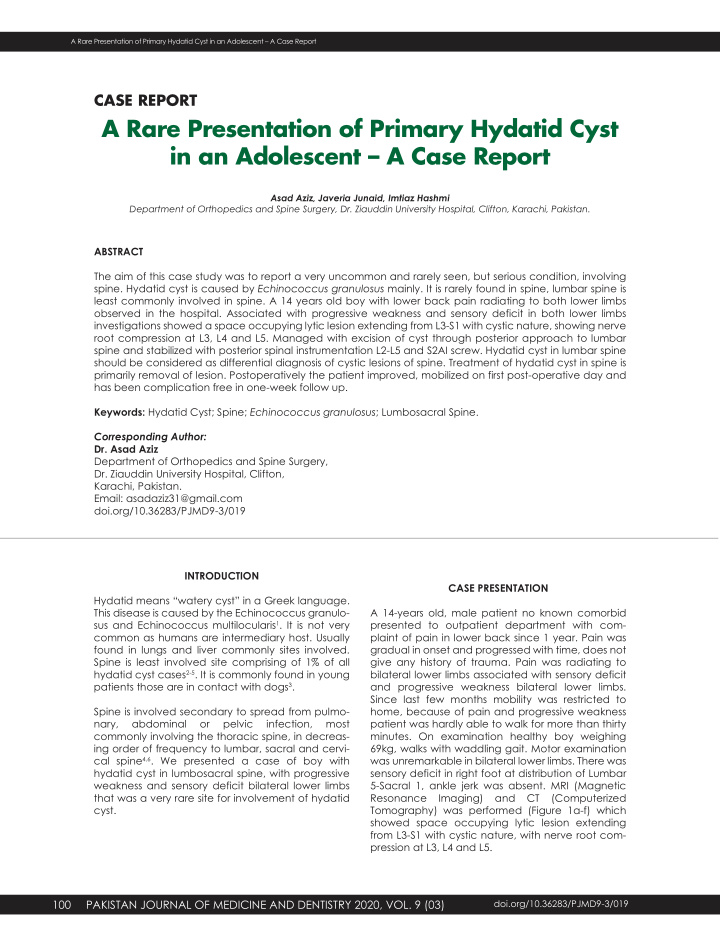



A Rare Presentation of Primary Hydatid Cyst in an Adolescent – A Case Report CASE REPORT A Rare Presentation of Primary Hydatid Cyst in an Adolescent – A Case Report Asad Aziz, Javeria Junaid, Imtiaz Hashmi Department of Orthopedics and Spine Surgery, Dr. Ziauddin University Hospital, Clifton, Karachi, Pakistan. ABSTRACT The aim of this case study was to report a very uncommon and rarely seen, but serious condition, involving spine. Hydatid cyst is caused by Echinococcus granulosus mainly. It is rarely found in spine, lumbar spine is least commonly involved in spine. A 14 years old boy with lower back pain radiating to both lower limbs observed in the hospital. Associated with progressive weakness and sensory deficit in both lower limbs investigations showed a space occupying lytic lesion extending from L3-S1 with cystic nature, showing nerve root compression at L3, L4 and L5. Managed with excision of cyst through posterior approach to lumbar spine and stabilized with posterior spinal instrumentation L2-L5 and S2AI screw. Hydatid cyst in lumbar spine should be considered as differential diagnosis of cystic lesions of spine. Treatment of hydatid cyst in spine is primarily removal of lesion. Postoperatively the patient improved, mobilized on first post-operative day and has been complication free in one-week follow up. Keywords: Hydatid Cyst; Spine; Echinococcus granulosus ; Lumbosacral Spine. Corresponding Author: Dr. Asad Aziz Department of Orthopedics and Spine Surgery, Dr. Ziauddin University Hospital, Clifton, Karachi, Pakistan. Email: asadaziz31@gmail.com doi.org/10.36283/PJMD9-3/019 INTRODUCTION CASE PRESENTATION Hydatid means “watery cyst” in a Greek language. This disease is caused by the Echinococcus granulo- A 14-years old, male patient no known comorbid sus and Echinococcus multilocularis 1 . It is not very presented to outpatient department with com- common as humans are intermediary host. Usually plaint of pain in lower back since 1 year. Pain was found in lungs and liver commonly sites involved. gradual in onset and progressed with time, does not Spine is least involved site comprising of 1% of all give any history of trauma. Pain was radiating to hydatid cyst cases 2-5 . It is commonly found in young bilateral lower limbs associated with sensory deficit patients those are in contact with dogs 3 . and progressive weakness bilateral lower limbs. Since last few months mobility was restricted to Spine is involved secondary to spread from pulmo- home, because of pain and progressive weakness nary, abdominal or pelvic infection, most patient was hardly able to walk for more than thirty commonly involving the thoracic spine, in decreas- minutes. On examination healthy boy weighing ing order of frequency to lumbar, sacral and cervi- 69kg, walks with waddling gait. Motor examination cal spine 4,6 . We presented a case of boy with was unremarkable in bilateral lower limbs. There was hydatid cyst in lumbosacral spine, with progressive sensory deficit in right foot at distribution of Lumbar weakness and sensory deficit bilateral lower limbs 5-Sacral 1, ankle jerk was absent. MRI (Magnetic that was a very rare site for involvement of hydatid Resonance Imaging) and CT (Computerized cyst. Tomography) was performed (Figure 1a-f) which showed space occupying lytic lesion extending from L3-S1 with cystic nature, with nerve root com- pression at L3, L4 and L5. 100 PAKISTAN JOURNAL OF MEDICINE AND DENTISTRY 2020, VOL. 9 (03) doi.org/10.36283/PJMD9-3/019
Asad Aziz, Javeria Junaid, Imtiaz Hashmi (a) (b) (c) (d) (e) (f) Figure 1: (a) Coronal cuts of CT scan showing involvement and extant of cyst in lumbosacral spine, also involving the right side sacrum (b) Sagittal cut of MRI T-1 image – showing dark signals around the involved area, as CSF and fluid appears dark. Sagittal cut of MRI (c) T-2 image – showing high uptake along posterior border of L3-S1 also involving vertebral body of S1 (d, e) Peroperative images of cyst andfusion sugery (f) Postoperative removed cyst. Patient was planned for excision of cystic lesion and L2-L5 and S2A1 screw (Sacrum 2 Alar iliac) connect- spinal instrumentation through posterior approach. ed with rods and connector (Figure 2a, b). Later After taking consent from family patient was given decompression was completed and curettage of general anesthesia and was kept in prone position, all necrotic bone was performed and irrigation skin incision was given following midline approach done with hypertonic saline. Patient remained to lumbo-sacral spine. While doing soft tissue dissec- stable on immediate post-operative day, with tion he was found to have cystic lesion extending intact lower limbs neurology. Patient was ambulat- from spine superficially on right side with clear fluid ed full weight bearing on first post operation day and lytic sacral bone. Cyst was excised completely without any brace, with relieved pre-operative and sent for frozen section per-operatively and it symptoms; hospital course was uneventful and came out to be hydatid cyst. Excision was done discharged home on fourth post-operative day followed by posterior spinal instrumentation from without any walking aid. doi.org/10.36283/PJMD9-3/019 PAKISTAN JOURNAL OF MEDICINE AND DENTISTRY 2020, VOL. 9 (03) 101
Recommend
More recommend